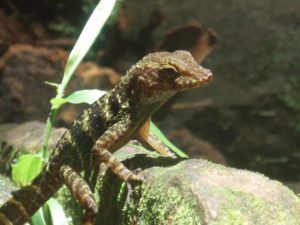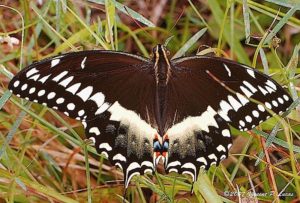 Luquillo Forest in Puerto Rico
Luquillo Forest in Puerto Rico
While I usually blog about insects (and plant pathogens) that have invaded new ecosystems and are killing native plant species, I am aware that insects are numerous and vitally important components of the ecosystems in which they evolved. I join others in noting with concern evidence that insect populations in wide-apart areas have declined at very high rates. Insects appear to be affected by the Sixth Extinction Event (concept described here and here) as much as or possibly more than various vertebrate and plant taxonomic groups.
The Zoological Society of London and World Wildlife Fund published this week the 2016 version of the Living Planet report. Based on an analysis of 3,700 vertebrate species (birds, fish, mammals, amphibians and reptiles), the authors concluded that global wildlife populations have fallen by 58% since 1970 (Morelle; see references at the end of the blog).
Dirzo et al. in 2014 provided a very interesting discussion of the impacts of species’ declines in numbers and local extinctions – short of complete extinction. They asserted that “declines in numbers of individuals in local populations and changes in the composition of species in a community will generally cause greater impacts on ecosystem function than global extinctions. Dirzo et al. noted the importance of invertebrates, especially insects, in ecosystem functioning. They stated that the smaller fauna – including insects – “arguably are more functionally important” than charismatic megafauna and called for improved monitoring and study of such taxa, particularly invertebrates,
In their study, Dirzo et al. estimated that, since 1970, Lepidoptera – an order containing many important pollinators – had declined 35% in abundance globally over 40 years. Declines of other insect orders were considerably more. One study they cited found an overall 45% decline for all invertebrate populations over 35 years. More recent studies find decline rates that considerably exceed the estimated decline of 58% in global abundance of wild vertebrates over a 42-year period (Morelle; Hallmann et al.)
A year ago, Hallmann et al. reported a 76% decline in the biomass of flying insects over a 27-year period in Germany. There were seasonal variations; in midsummer, when insect biomass is highest, the decline was 82%. The study was carried out in nature protection areas – that is, places set aside and protected to conserve biological diversity. Hallmann et al. predict cascading effects on food webs and jeopardy to ecosystem services, including pollination, herbivory and breakdown of detritus, nutrient cycling and providing a food source for higher trophic levels such as birds, mammals and amphibians.
Hallmann et al. said that changes in weather, land use, and habitat characteristics could not explain this overall decline. Declines occurred in both nutrient-poor habitat types (e.g., heathlands, sandy grasslands, and dunes) and nutrient-rich habitats (grasslands, margins and wasteland), as well as in pioneer and shrub communities.
Another of the few studies looking at insects broadly, a study of flying insect biomass in the United Kingdom, found a biomass decline at only one of the four sites. Hallmann et al. note that the British researchers used considerably different sampling methods that targetted primarily high-flying insects (and caught mostly members of one fly family) whereas their own Malaise traps caught insects flying close to the ground and a much wider diversity of taxa.
Taxon-specific studies have also found severe declines in insect populations.
Hallmann et al. concluded that the scale of decline in insect biomass – throughout the growing season, and irrespective of habitat type or landscape configuration – suggest that large-scale factors must be involved. As noted, their data did not support either landscape changes or climate change as explanatory factors – although they admit that they did not exhaustively analyze the full range of climatic variables that could potentially impact insect biomass. Hallmann et al. did think that agricultural intensification (e.g. pesticide usage, year-round tillage, increased use of fertilizers and frequency of agronomic measures) was a plausible cause of insect biomass decline given the reserves’ limited size in typically fragmented western-European landscapes. The noted that the protected areas might serve as insect sources which might be counterbalanced by the surrounding agricultural fields, which might act as sinks or ecological traps.
While Hallman et al. did not specify the types of pesticides being used by the German farmers operating near their study areas, in recent years there has been growing concern about widespread use of neonicotenoids, which appear to pose a threat to bees and possibly other insects. Three sources of information are the European Food Safety Agency; Xerxes Society; and petition pertaining to regulation of seeds treated by neonicotenoids submitted by the Center for Food Safety.
This month, Bradford Lister and Andrés García published a study that compared numbers of the insects and insectivores (birds, frogs, lizards) in Puerto Rico’s tropical rainforest in 2012 to results of Lister’s studies there in 1976 and 1977. Overall arthropod biomass in Puerto Rico’s Luquillo rainforest fell 10 to 60 times since 1970s (Lister and Garcia). Numbers of insects in the vegetation collected by sweep nets decreased to a fourth or an eighth of what they had been. The catch rate of ground-dwelling arthropods caught in sticky traps fell 60-fold (Guarino).
Lister and Garcia attribute the crash in arthropod numbers to climate change, especially rising maximum temperatures. They note that over the same 40-year period, the average high temperature in the rainforest increased by 4 degrees Fahrenheit (2oC). Lister and Garcia cite several studies indicating that tropical invertebrates are adapted to a narrow band of temperatures.
Lister and Garcia also measured declines among insect-feeding vertebrates. The biomass of anole lizards dropped by more than 30%. Some anole species disappeared from the interior forest (Guarino). Declines in number of coqui frogs (Eleutherodactylus spp) began in the 1970s. Currently, three of 16 species are extinct, and the remaining 13 species are classified in some category of endangered or threatened. Disease caused by the fungus Batrachochytrium dendrobatidis is not a factor at the elevations where study done.

Citing data from other researchers, Lister and Garcia report that numbers of insectivorous birds captured in mist nets fell 53% between 1990 and 2005.
Lister and Garcia sought to explain why there were simultaneous, long-term declines in arthropods, lizards, frogs, and birds over the past four decades in the relatively undisturbed rainforests of northeastern Puerto Rico. They concluded that climate warming has been a major factor driving reductions in arthropod abundance, and that these declines have in turn precipitated decreases in forest insectivores in a classic bottom-up cascade.
As supporting evidence, Lister and Garcia cite
(1) Declines across varied species and communities that occurred in parallel with rising temperatures.
(2) Simultaneous declines of all arthropod taxa in their own and others’ studies – pointing to an overriding environmental factor that has had ubiquitous, adverse effects on forest arthropods regardless of taxonomic affiliation, stratum occupied, or type of niche exploited.
(3) Declines in arthropod abundance that occurred despite major decreases in their predators – and, presumably, reduced predatory pressure..
Lister and Garcia note that there have been almost no significant human perturbations in the Luquillo forest since the 1930s, and that pesticide use in Puerto Rico fell nearly 80% over the past 40 years with the decrease in agricultural activity on the island. Some of the insect trend data came from studies carried out in the Luquillo Long Term Ecological Study site.
Lister and Garcia say that major weather perturbations have also had an impact. Over the 36-year time span, there have been five major hurricanes and eight severe droughts. They note that the island’s vegetation regenerated rapidly after hurricanes Hugo and Maria; insect populations regenerated rapidly after Hurricane Georges. La Niña episodes led to an immediate increase in the abundance of canopy invertebrates, whereas El Niño episodes caused declines.
Of course, some insects are under threat from loss of their primary food plants to invasive species. I note particularly the Palamedes swallowtail butterfly (Papilio palamedes), which depends on redbay and swamp bay, and an estimated 21 species of North American butterflies and moths believed to specialists or largely dependent on ash.
Palamedes swallowtail; photo by Vincent P. Lucas
In some cases, e.g., hemlock woolly adelgid and Asian longhorned beetle, neonicotenoids, specifically imidacloprid, is an essential tool to controlling a tree-killing invasive insect.
We welcome comments that supplement or correct factual information, suggest new approaches, or promote thoughtful consideration. We post comments that disagree with us — but not those we judge to be not civil or inflammatory.
SOURCES
Dirzo, R., H.S. Young, M. Galetti, G. Ceballos, N.J. B. Isaac, B. Collen. 2014. Defaunation in the Anthropocene. Science 345, 401
Guarino, B. 2018. ‘Hyperalarming’ study shows massive insect loss. 2018. The Washington Post October 15 2018
Hallmann CA, Sorg M, Jongejans E, Siepel H, Hofland N, Schwan H, et al. 2017. More than 75 percent decline over 27 years in total flying insect biomass in protected areas. PLoS ONE 12 (10): e0185809. https://doi.org/10.1371/journal. pone.0185809
Lister, B.C. and A. Garcia. 2018. Climate-driven declines in arthropod abundance restructure a rainforest food web. Proceedings of the National Academy of Sciences. http://www.pnas.org/content/early/2018/10/09/1722477115
Morelle, R. Science Correspondent, BBC News. 2018. World wildlife ‘falls by 58% in 40 years’ https://www.bbc.com/news/science-environment-37775622


